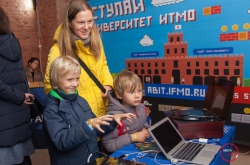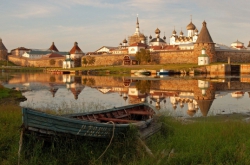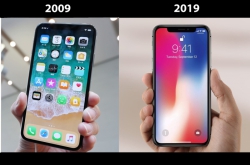Science Fest
The festival’s motto is “It’s fashionable to be smart!”. The event drew programmers, roboteers, gamers, geeks and fans of popular science. Throughout the two days more than 20 speakers held lectures, the first hackathon in visual art took place, and more than 100 participants showcased their projects and ideas in five categories: “Robots, drones and other mechanisms”, “Augmented and virtual reality”, “Lighting design”, “3D printers, nanotechnologies and food industry” and “Neural interfaces”. In addition, musicians and performers entertained the guests and thematic workshops were available.
The event featured several interactive areas. The guests were greeted by a robot equipped with a high-precision navigation system allowing it to quickly find its way around the creative space. The participants demonstrated robotic arm manipulators, 3D-printers, eye trackers and brain stimulation helmets. Special areas were provided where everyone could experience virtual or augmented reality. Guests were able to watch 360-degree movies, fully immerse themselves into a game by wearing a VR-costume and watch the news in virtual reality.

ITMO University's area at Science Fest
Several universities prepared their own areas for fans of science, among them the Polytechnical University, Moscow Technological Institute and, of course, ITMO University. The first non-classical university presented its guests with projects by FabLab and OLYMP laboratory. Visitors could acquaint themselves with 3D-printing, laser engraving, see an active bioreactor, try to find their way through an “optical labyrinth”, operate a robotic platform, learn about “smart house” technology and the making process of manipulator robots. The university’s area was the largest and most varied at Science Fest.
The first day of the festival was dedicated to VR technology and the sciences of mind and space. The second day continued with these topics, but also focused more on integration of robots into everyday life. ITMO.NEWS explores the first day’s topics.
Growth Drivers of VR Technology
Virtual, augmented, mixed realities – these are the future areas of study for high-end experts, claims Roman Povolotskiy, head of project “Cyber Russia”. Roman spoke of the key development vectors in these industries and explained why one has to pay attention to them even now.
VR has several very stable growth drivers that aren’t going away anytime soon. Firstly, such technology allows people to handle the ever-increasing amount of information in all spheres of life. For instance, when performing quality control by a conveyor belt, all the human operator will have to do is to glance at a particular product and the detailed information on it will appear to them through augmented reality. A surgeon can track the patient’s vitals using the very same augmented reality without having to be distracted by monitors. Devices exist already that allow multiple people to work on the same project, like, say, a blueprint of a building, despite being thousands of miles away. Thus VR can visually recreate environments that don’t yet exist or are hard to reproduce through other methods. The second growth driver for VR is its capability to replace workers in certain industries and reduce the costs.

Thirdly, VR development will be constantly stimulated by gamers. These are the people who are the first to dash to the store to get all the new consoles and gizmos that allow them to gain more and more enjoyment from gaming. According to Mr. Povolotskiy, this market is especially big in the USA where people have too many limitations and social responsibilities. Meanwhile, games allow people to distract themselves from the routine and enter worlds where they are in control of things. VR’s popularity is also helped by climate: when the weather is bad, people spend more time indoors. Television, news and film have already become trite to them, so people are starting to play more games. VR-based adventure games are becoming more and more popular.
“It’s like a socializing tool – especially in families where parents have a hard time establishing a relationship with the kids. When they play games where they have to help each other complete tasks, it can somewhat help them strengthen the relationship. Games like this can also help couples: psychologically, it doesn’t matter to one’s partner if you save them in a game or in real life”, - says Povolotsky.
The current market is already in need of people who can develop and sell VR applications, he adds. The demand is high, but the number of developers is not that high. Practice shows that careers in IT often start with interest in game development. The modern “arms race” between tech companies leads to development speed becoming a critical factor. For this reasons hackathons, where teams have to complete a project in two days, are becoming more and more popular. Such events develop teamwork skills that are later applied in actual work.
VR for movie makers
Maxim Nikonov, co-founder and director at virtual reality studio LenVR, spoke about the perspectives for use of VR in feature films and documentaries. Big-name directors are only now starting to experiment with the new genre of 360-degree filmmaking. The challenge is that working with virtual reality has its own limits: how do you make such a movie and manage to hide the cameraman from the viewer?
Imagine you have the shot of a character walking on a street. Where is the filming crew supposed to be? After all, the viewer can look anywhere: up, down, behind. Or another example: let’s imagine that the director wants a close-up of a character’s eyes. In a regular film, the camera would simply zoom in on the eyes, but in 360 it’ll just seem like the viewer has been pushed toward the character. The feeling would be strange, to say the least. Because of this, in-frame staging and editing becomes much more important in VR film than it is in classical cinema.

Science Fest. Credit: social media
For now there is very little progress achieved in that field: few understand how to use it and how to work with it, even though everybody knows it’s the future, notes Mr. Nikonov. Companies are starting to get interested in VR-films and use the technology to advertise their products. It’s also great for making spectacular clips of various tourist destinations and cities. VR can allow to reconstruct certain events, meaning that can also be used as an educational tool.
“A new trend is forming that is not well-explored at the moment. There’s a lot of room for creativity here, you can write articles on it and conduct research. It’s not clear yet how to make return on investments in VR-film. If we’re talking about films as entertainment, then the most profitable strategy is probably selling VR-films akin to games, in that people will be able to download them online and watch them at home. Imagine being able to go inside “Lord of the Rings” or “Matrix” – the experience would be completely different than from a regular movie”, - explains Maxim Nikonov.
Functional food of the future
Besides VR, there were many other fascinating topics at the festival. Alexander Ishevsky, head of ITMO University’s Department of Meat and Fish Processing and Refrigeration, spoke about the inevitable future in which functional food will enter our everyday life. Why is it inevitable? First of all, each day there is less and less land available for cattle and cultivation, yet the demand for food products increases with each year. Secondly, the quality of food on the shelves is diminishing. It happens because as the prices for quality food rise, customers cease to buy it. As a result, manufacturers have to find new recipes that will make production cheaper at the cost of lower quality of product. Thirdly, modern technology allows us to produce functional food. But what is it?
“Functional nutrition is a systematic consumption of natural food that generally determines the organism’s regular operation. That doesn’t mean that if your kidney fell off, you can just eat some functional food and grow it back, no. But functional food is intended to serve as a preventative measure against this or that illness. Functional products can’t be cheap: the price for high-quality ingredients is high and it’s affected by seasons, the population’s financial solvency and the specifics of the market”, - says Alexander Ishevsky.

Alexander Ishevsky
According to estimates, by 2030 the problems related to maximal improvement of medical edibles should be solved. For example, you could eat an apple and recover from flu, as the apple contained an antigen that eliminates the pathogenic organisms. Thus the creation of functional food is aided by gene modification. The most well-known example of such a product is “golden” rice. It is the first crop plant to be genetically modified to increase its nutritional properties: the granules contain an increased amount of beta-carotene. It was created to treat the lack of vitamin A in the population of the world’s poorest countries.
Mr. Ishevsky then brought up another example: the technology of functional food can be useful both to the manufacturer in an economical sense and to the consumer in terms of product quality. There is a type of pork in which fat is alternated with muscle tissue. To produce it, farmers maintain a special feeding procedure, which makes this sort of meat costly. However, one could take a ferment and use it to “entwine” the fat and muscle tissue together and produce the same end product for less money. Another example: modern technology can be used to enrich drinking water with microelements needed for proper function of vital organs.
A bit about space
It’s no science festival if there’s no talk of space. It’s been a while since the first man reached the low earth orbit. At some point humanity’s interest in space waned, but now with the new plans to conquer the Universe, space tech is once again a hot topic in the news. Science Fest was visited by a special guest – the Soviet and Russian airsports athlete and astronaut Sergei Krikalev, who, from October 2005 to June 2015 held the world record for total time spent in space (803 days over six missions). Instead of giving a lecture, he decided to talk to the festival’s visitors and answer some of their questions. ITMO.NEWS wrote down some of his words.
 Science Fest. Credit: social media
Science Fest. Credit: social media
On space exploration
“As for the fact that we’ve forgotten about space for a while – that’s natural. You climb a step and then you assimilate there. You know, we used to build rafts to cross rivers and now there are ships capable of spending weeks at sea. Same with pilots – when they appeared, their ability to flight was akin to a circus stunt. After we’ve conquered near space, there came a lull, but for those who worked on technology, this field was still highly active. The world was at a stage of space exploration where we were only trying to decide where it is that we want to go in the Universe. Right now we’re at the assimilation stage; man’s next step will be leaving the low Earth orbit".
On extraterrestrial life
“Yes, I believe that extraterrestrial life exists. Space is too big for us to be the only ones in the Universe. But in all my career I’ve never encountered any evidence of its existence. Which is why I’m only saying I believe it; I can’t know for sure if there is indeed someone else in the Universe”.
On ISS renovation, selection of astronauts and manned missions
“ISS does indeed consist of modules from different countries; if one country refuses to fund the station, that doesn’t mean that others will do the same. I can’t say what will happen to it - the future remains to be seen. Yes, “Roscosmos” is hiring astronauts now: it’s at an early stage now, we’re just checking the applicants’ documentation. Among other things, they will become the first pilots of a new spaceship that is expected to launch sometime in 2023-2024”.
On protecting astronauts from external effects in space
We’re protected from radiation by Earth’s magnetic field and atmosphere. When we’re in low Earth orbit, we pass over the poles and clip them a little. Solar flares can have a negative effect on spacecraft and people, but there is a system that monitors “space weather”. When we have to leave the station in just a spacesuit, the spacewalk is usually timed to coincide with a period without solar flares. Even if there’s a safety hazard inside the station, the construction is such that most of the equipment is by the walls while the crew are in the center.”
On meteorite threat to Earth
“Meteorites fall on Earth every day. Some miniscule space dust often clips the space station too – you can see the marks and chippings on its surface. But the bigger the meteorite, the less likely we are to hit it. There are mathematical models that help calculate how much protection a spacecraft needs to ensure a safe flight. As for large meteorites that could cause a serious problem – they do exist. There is geological evidence of Earth having experience multiple collisions with huge celestial bodies. Because of that, systems that could predict and warn us of such collisions are being developed”.
On flying cities
“I’ve heard of the flying city concept. I think it’s a natural way of development for humanity. With the emergence of new technology, we move into new planes: in the water, in the air. It’d be cool to have something that is not on the ground, but above it. However, people have never lost their connection with Earth and they never will. Even when we leave Earth and go on long-term trips, we still plan to go back”.





